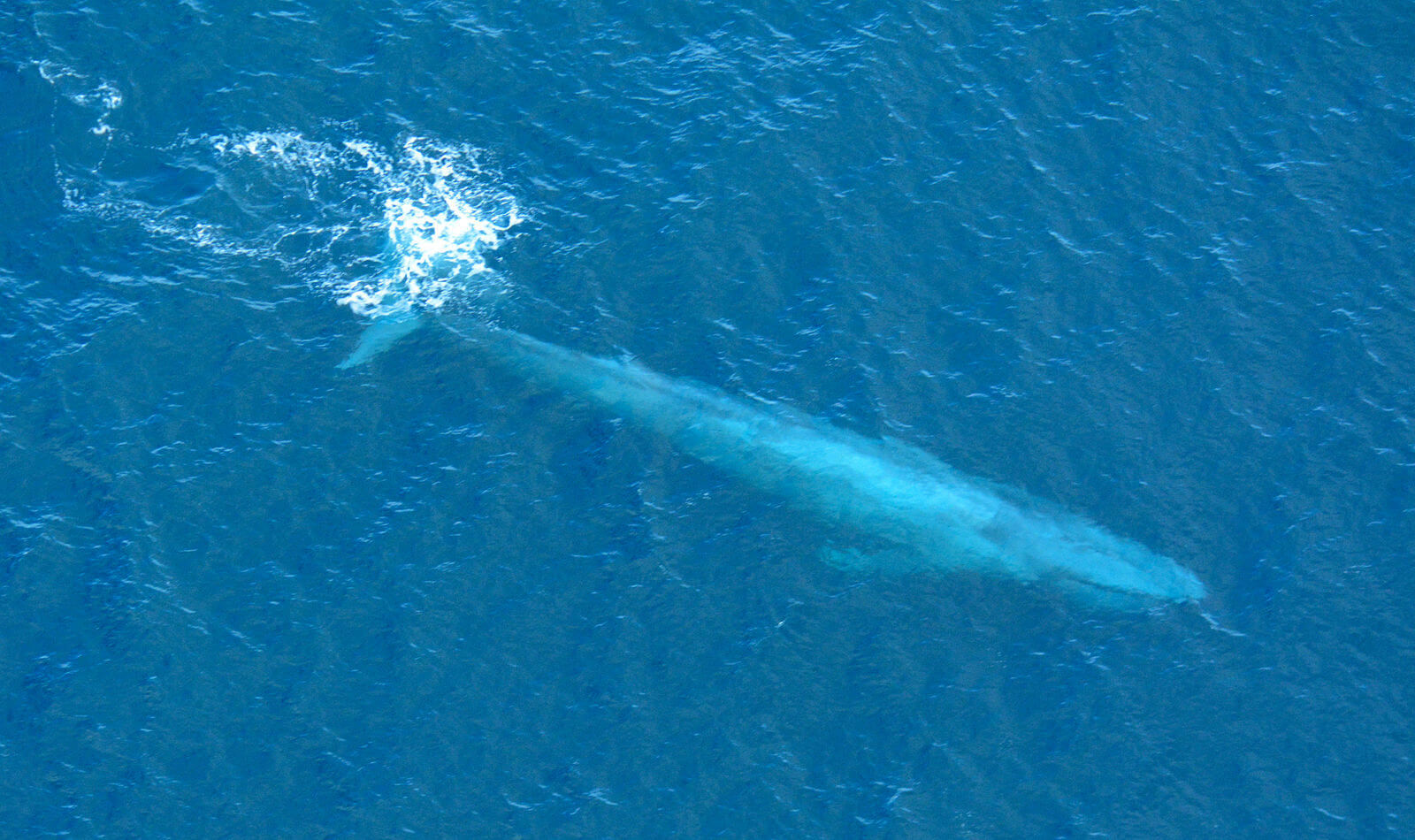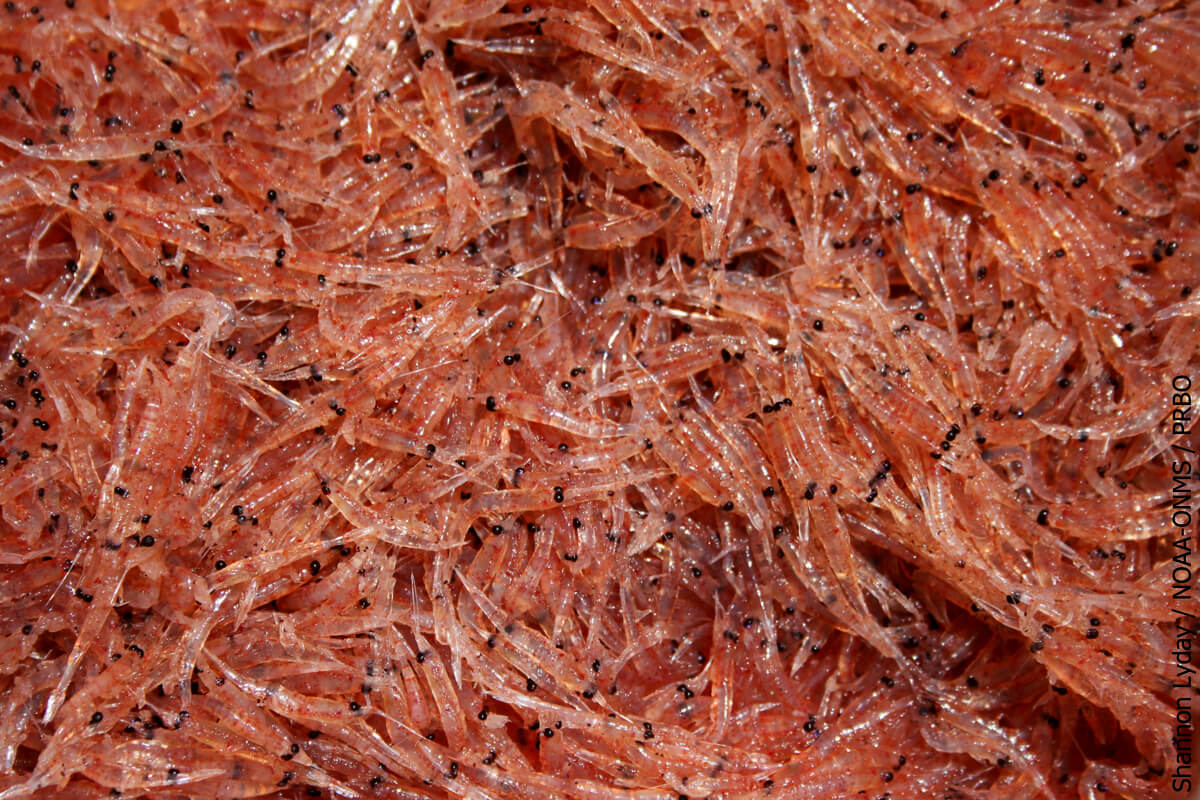Tipping the scales at up to 135 tonnes, the blue whale is the largest animal on our planet. Seeing the gigantic size of its jaw bone on display at the CIMM, visitors sometimes ask: how much food can this whale ingest in a one bite… in one day… in one year?
The blue whale feeds exclusively on a tiny crustacean called krill and eats it by the ton, literally. In a single day of feeding, a blue whale can ingest 16 tonnes of krill, or 12% of its own body weight! This is what we learn from a study published last November in the scientific journal Nature. Thus, members of this species might eat three times more prey than previously believed. Paradoxically, this is good news: the uptick in the number of whales could be even more beneficial than previously thought for the ocean ecosystem.
A seasonal hunter
The nature of the blue whale’s diet complicates any assessment of its appetite. To calculate the volume of prey a whale eats in a year, one cannot simply multiply the amount of food it consumes in a single day by the number of days in a year. The blue whale’s appetite is not constant from one season to another. Indeed, the blue whale is a migratory species that moves to higher latitudes in summer to reach nutrient-rich foraging areas, and migrates to lower latitudes in winter to reproduce. It is estimated that an individual ingests 83% of the calories it will need for the entire year in just 90 to 120 days. Researchers are therefore particularly interested in how whales feed during this season.
Three times hungrier than expected!
According to recent surveys by the Hopkins Marine Station team at Stanford University, a blue whale in the eastern North Pacific Ocean ingests an average of 16 tonnes of krill in a single day of feeding. In comparison, the North Atlantic right whale and bowhead whale are believed to consume 5 and 6 tonnes of small zooplankton per day, respectively.
Until now, it was estimated that baleen whales ate the equivalent of less than 5% of their total weight. It is now known that the quantity of prey (including krill, copepods or small fish, depending on the species) they consume represents 5 to 30% of their body mass. On average, it is 3 times more than previously thought! The fact that we have so underestimated the blue whale’s appetite completely changes our understanding of this animal’s dietary needs.
A more precise approach
In the past, two methods had been used to quantify the blue whale’s daily intake. The first method consists of analyzing the stomach contents of stranded whales, but in the absence of data related to digestion time, the rate at which they eat or prey density, this method remains imprecise. The second method entails quantifying the food using bioenergetic models based on odontocetes raised in captivity.
However, the Stanford University team used an innovative approach that is far more precise. To refine their estimates, researchers considered previously overlooked variables such as the animals’ feeding frequency and engulfing capacity as well as prey availability. In particular, they used echo sounders to measure the size and density of krill (article in French) and other species that whales prey upon.
The “krill paradox”
If whales eat more than previously estimated, should we be concerned about them running out of food? Not really, say scientists. In fact, the more krill whales eat, the larger the stocks of these tiny crustaceans grow, an astonishing but well-documented phenomenon. Incidentally, the decline of this zooplankton after the loss of many of its predators is called the “krill paradox.”
More than one hundred years ago, whales consumed twice as much krill every year as the total amount in the oceans today! This decline in krill occurred after large rorqual populations plummeted over 90% between the years 1900 and 2000, especially in the oceans of the southern hemisphere. This krill paradox is explained by an important function that baleen whales like the blue whale perform in their environment: nutrient recycling.
Whale excrement is a genuine fertilizer for krill. When whales defecate, nutrients such as iron become accessible to phytoplankton again and zooplankton productivity is increased. Whales consume krill, but also contribute to its proliferation. This is called a trophic feedback loop.
Good news for the marine ecosystem
The fact that the amount of prey ingested by whales has been underestimated suggests that we have also underestimated the role that whales play in the marine ecosystem. Whales are believed to fill a very important role in the health of the oceans.
“The recovery of baleen whales and their nutrient recycling services could augment productivity and restore ecosystem function lost during 20th century whaling,” conclude the authors of the recent Stanford University study.
Knowing this inspires a little hope.








